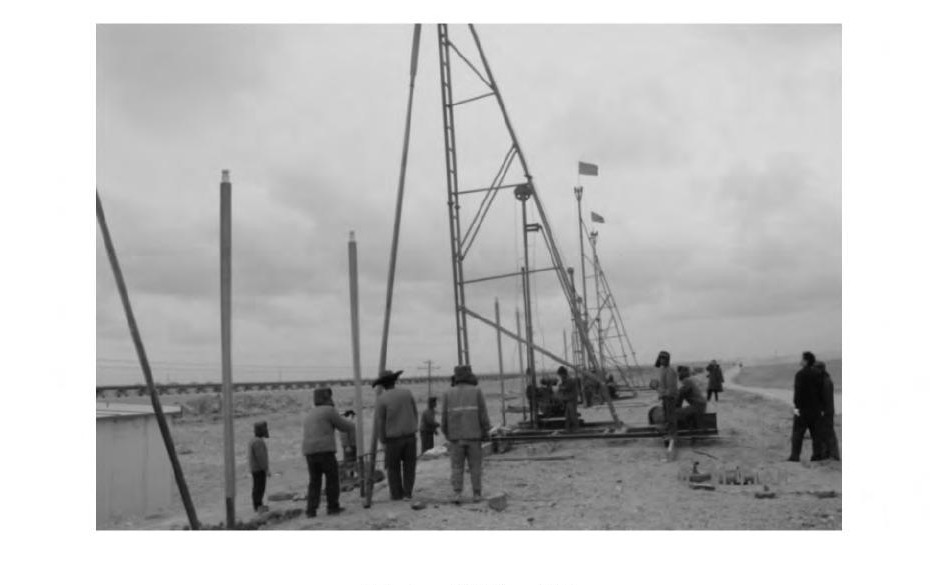Cooling effect of thermosyhpon subgrade for Qinghai-Tibet Highway
-
摘要: 为了分析多年冻土区热棒路基的工程效果, 定量评价其降温效能, 基于青藏公路热棒路基试验工程近11年的现场监测数据, 分析了热棒路基的地温特征、温度场形态和冻融过程, 估算了阴阳坡影响下热棒附近的水平热收支状况。建立了空气-热棒-冻土地基三维非稳态耦合计算模型, 分析了不同结构形式(单侧直插式、单侧斜插式、双侧直插式与双侧斜插式)的热棒路基的降温效能。实测结果表明: 在热棒作用下, 阳坡侧路基地温可降到-1.5℃附近, 较普通路基地温降低约3.0℃, 阴坡侧路基地温最低达到-2.1℃; 热棒路基经过11年的营运, 阳坡侧冻土上限抬升约0.95m, 基本达到天然地基水平; 阴阳坡两侧热棒的年平均实际功率分别约为69.80、54.07 W, 且热棒路基在最初5年传递能量较大, 第6年后逐渐减小, 此后路基的热状况进入相对稳定的状态。计算结果表明: 双侧直插式热棒路基与双侧斜插式热棒路基第20年冻土上限分别为2.88、1.88m, 而单侧直插式热棒路基与单侧斜插式热棒路基第20年冻土上限分别为3.84、3.46m, 因此, 双侧热棒路基的长期降温效果明显强于单侧热棒路基, 斜插式热棒路基强于直插式热棒路基; 单根热棒的年平均功率为47~56 W, 与试验工程监测结果较为吻合。Abstract: In order to analyze the engineering effect of thermosyphon subgrade in permafrost regions and quantitatively evaluate its cooling effect, the 11 years'observational data were collected from the thermosyphon subgrade test project of Qinghai-Tibet Highway, the ground temperature characteristics, temperature field profiles and freezing-thawing process of thermosyphon subgrade were analyzed, and the horizontal thermal budget near the thermosyphons under the influence of shady-sunny slope effect was evaluated. A threedimensional unsteady coupled air-thermosyphon-foundation computation model was proposed, and the cooling effects of thermosyphon subgrades with different structures, such as one-side vertical type, one-side inclined type, two-side vertical type and two-side inclined type, were investigated. Measured result shows that the monitoring data indicates that the ground temperature of thermosyphon subgrade at sunny side is about-1.5 ℃, 3.0 ℃ lower than thevalue of traditional subgrade, and the lowest ground temperature at shady side can reach to-2. 1 ℃. During 11years'operation of thermosyphon subgrade, the permafrost table at sunny side elevates about 0.95 m, and basically reaches to the level of natural foundation. The mean annual actual powers of thermosyphon subgrades at shady side and sunny side are about 69. 80 and 54.07 W, respectively. During the previous 5years, the thermosyphon presents a larger power. After 6th year, the power gradually decreases, and the thermal state of subgrade tends towards stability. Calculated result shows that after 20 years, the permafrost tables under the two-side vertical and inclined type thermosyphon subgrades are 2.88 and 1.88 mrespectively, the permafrost tables under one-side vertical and inclined type thermosyphon subgrades are 3. 84and3. 46 m, respectively, so, the two-side type thermosyphon subgrade expresses a stronger longterm cooling effect than the one-side type thermosyphon subgrade, similarly, the inclined type thermosyphon subgrade has a stronger cooling effect than the vertical type thermosyphon subgrade. The annual average power of one thermosyphon varies from 47 Wto 56 W, agreeing well with the monitoring data.
-
表 1 地层属性
Table 1. Stratum properties

表 2 地层热物理参数
Table 2. Thermophysical parameters of stratums

表 3 阳坡侧热棒水平热量估算结果
Table 3. Horizontal thermal budget's evaluation result of thermosyphon at sunny side

表 4 阴坡侧热棒水平热量估算结果
Table 4. Horizontal thermal budget's evaluation result of thermosyphon at shady side

表 5 地层热物理计算参数
Table 5. Thermophysical computation parameters of stratums

-
[1] CHENG Guo-dong. A roadbed cooling approach for the construction of Qinghai-Tibet Railway[J]. Cold Regions Science and Technology, 2005, 42(2): 169-176. doi: 10.1016/j.coldregions.2005.01.002 [2] 程国栋, 何平. 多年冻土地区线性工程建设[J]. 冰川冻土, 2001, 23(3): 213-217. doi: 10.3969/j.issn.1000-0240.2001.03.001CHENG Guo-dong, HE Ping. Linearity engineering in permafrost areas[J]. Journal of Glaciology and Geocryology, 2001, 23(3): 213-217. (in Chinese). doi: 10.3969/j.issn.1000-0240.2001.03.001 [3] XU Jian-feng, GOERING D J. Experimental validation of passive permafrost cooling systems[J]. Cold Regions Science and Technology, 2008, 53(3): 283-297. doi: 10.1016/j.coldregions.2007.09.002 [4] CHENG Guo-dong, SUN Zhi-zhong, NIU Fu-jun. Application of the roadbed cooling approach in Qinghai-Tibet Railway engineering[J]. Cold Regions Science and Technology, 2008, 53(3): 241-258. doi: 10.1016/j.coldregions.2007.02.006 [5] WU Qing-bai, LI Shu-xun, LIU Yong-zhi. The impact of climate warming on permafrost and Qinghai-Tibet Railway[J]. Engineering Sciences, 2006, 4(2): 92-97. [6] SUN Zhi-zhong, MA Wei, LI Dong-qing. In situ test on cooling effectiveness of air convection embankment with crushed rock slope protection in permafrost regions[J]. Journal of Cold Regions Engineering, 2005, 19(2): 38-51. doi: 10.1061/(ASCE)0887-381X(2005)19:2(38) [7] GOERING D J. Passively cooled railway embankments for use in permafrost areas[J]. Journal of Cold Regions Engineering, 2003, 17(3): 119-133. doi: 10.1061/(ASCE)0887-381X(2003)17:3(119) [8] LAI Yuan-ming, ZHANG Lu-xin, ZHANG Shu-juan, et al. Cooling effect of ripped-stone embankments on Qing-Tibet Railway under climatic warming[J]. Chinese Science Bulletin, 2003, 48(6): 598-604. doi: 10.1360/03tb9127 [9] 汪双杰, 黄晓明, 陈建兵, 等. 无动力热棒冷却冻土路基研究[J]. 公路交通科技, 2005, 22(3): 1-4. doi: 10.3969/j.issn.1002-0268.2005.03.001WANG Shuang-jie, HUANG Xiao-ming, CHEN Jian-bing, et al. Research on frozen soil subgrade cooling by non-power heat pipe[J]. Journal of Highway and Transportation Research and Development, 2005, 22(3): 1-4. (in Chinese). doi: 10.3969/j.issn.1002-0268.2005.03.001 [10] 杨永平, 魏庆朝, 周顺华, 等. 热管技术及其在多年冻土工程中的应用研究[J]. 岩土工程学报, 2005, 27(6): 698-706. doi: 10.3321/j.issn:1000-4548.2005.06.019YANG Yong-ping, WEI Qing-chao, ZHOU Shun-hua, et al. Thermosyphon technology and its application in permafrost[J]. Chinese Journal of Geotechnical Engineering, 2005, 27(6): 698-706. (in Chinese). doi: 10.3321/j.issn:1000-4548.2005.06.019 [11] 盛煜, 张鲁新, 杨成松, 等. 保温处理措施在多年冻土区道路工程中的应用[J]. 冰川冻土, 2002, 24(5): 618-622. doi: 10.3969/j.issn.1000-0240.2002.05.025SHENG Yu, ZHANG Lu-xin, YANG Cheng-song, et al. Application of thermal-insulation treatment to roadway engineering in permafrost regions[J]. Journal of Glaciology and Geocryology, 2002, 24(5): 618-622. (in Chinese). doi: 10.3969/j.issn.1000-0240.2002.05.025 [12] FARSI H, JOLY J L, MISCEVIC M, et al. An experimental and theoretical investigation of the transient behavior of a two-phase closed thermosyphon[J]. Applied Thermal Engineering, 2003, 23(15): 1895-1912. doi: 10.1016/S1359-4311(03)00147-9 [13] NOIE S H. Heat transfer characteristics of a two-phase closed thermosyphon[J]. Applied Thermal Engineering, 2005, 25(4): 495-506. doi: 10.1016/j.applthermaleng.2004.06.019 [14] 潘卫东, 连逢愈, 邓宏艳, 等. 寒区工程中热棒技术的应用原理和前景[J]. 岩石力学与工程学报, 2003, 22(增2): 2673-2676. https://www.cnki.com.cn/Article/CJFDTOTAL-YSLX2003S2027.htmPAN Wei-dong, LIAN Feng-yu, DENG Hong-yan, et al. Application principle and prospect of thermal-probe technique in cold regions engineering[J]. Chinese Journal of Rock Mechanics and Engineering, 2003, 22(S2): 2673-2676. (in Chinese). https://www.cnki.com.cn/Article/CJFDTOTAL-YSLX2003S2027.htm [15] SONG Yi, JIN Long, ZHANG Jin-zhao. In-situ study on cooling characteristics of two-phase closed thermosyphon embankment of Qinghai-Tibet Highway in permafrost regions[J]. Cold Regions Science and Technology, 2013, 93: 12-19. doi: 10.1016/j.coldregions.2013.05.002 [16] WU Di, JIN Long, PENG Jian-bing, et al. The thermal budget evaluation of the two-phase closed thermosyphon embankment of the Qinghai-Tibet Highway in permafrost regions[J]. Cold Regions Science and Technology, 2014, 103: 115-122. doi: 10.1016/j.coldregions.2014.03.013 [17] 程红彬. 青藏铁路冻土区低温热管应用关键技术研究[D]. 兰州: 中国科学院寒区旱区环境与工程研究所, 2007.CHENG Hong-bin. The key technology study of low temperature heat pipe of Qinghai-Tibet Railway in permafrost regions[D]. Lanzhou: Cold and Arid Regions Environmental and Engineering Research Institute, Chinese Academy of Sciences, 2007. (in Chinese). [18] MU Yan-hu, WANG Guo-shuang, YU Qi-hao, et al. Thermal performance of a combined cooling method of thermosyphons and insulation boards for tower foundation soils along the Qinghai-Tibet Power Transmission Line[J]. Cold Regions Science and Technology, 2016, 121: 226-236. doi: 10.1016/j.coldregions.2015.06.006 [19] LAI Yuan-ming, GUO Hong-xin, DONG Yuan-hong. Laboratory investigation on the cooling effect of the embankment with L-shaped thermosyphon and crushed-rock revetment in permafrost regions[J]. Cold Regions Science and Technology, 2009, 58(3): 143-150. doi: 10.1016/j.coldregions.2009.05.002 [20] ZHANG Ming-yi, LAI Yuan-ming, WU Qing-bai, et al. A fullscale field experiment to evaluate the cooling performance of a novel composite embankment in permafrost regions[J]. International Journal of Heat and Mass Transfer, 2016, 95: 1047-1056. doi: 10.1016/j.ijheatmasstransfer.2015.12.067 [21] 董元宏, 赖远明, 陈武. 多年冻土区宽幅公路路基降温效果研究——一种L型热管-块碎石护坡复合路基[J]. 岩土工程学报, 2012, 34(6): 1043-1049. https://www.cnki.com.cn/Article/CJFDTOTAL-YTGC201206014.htmDONG Yuan-hong, LAI Yuan-ming, CHEN Wu. Cooling effect of combined L-shaped thermosyphon, crushed-rock revetment and insulation for high-grade highways in permafrost regions[J]. Chinese Journal of Geotechnical Engineering, 2012, 34(6): 1043-1049. (in Chinese). https://www.cnki.com.cn/Article/CJFDTOTAL-YTGC201206014.htm [22] 杨永平, 周顺华, 魏庆朝. 青藏铁路斜插式热管路基在不同倾斜角度下冷却效果的数值模拟研究[J]. 土木工程学报, 2006, 39(3): 108-113. https://www.cnki.com.cn/Article/CJFDTOTAL-TMGC200603016.htmYANG Yong-ping, ZHOU Shun-hua, WEI Qing-chao. Effect simulation of different declining angles of thermosyphons used in Qinghai-Tibet Railway permafrost embankment[J]. China Civil Engineering Journal, 2006, 39(3): 108-113. (in Chinese). https://www.cnki.com.cn/Article/CJFDTOTAL-TMGC200603016.htm [23] 田亚护, 刘建坤, 沈宇鹏. 青藏铁路多年冻土区热棒路基的冷却效果三维有限元分析[J]. 岩土工程学报, 2013, 35(增2): 113-119. https://www.cnki.com.cn/Article/CJFDTOTAL-YTGC2013S2020.htmTIAN Ya-hu, LIU Jian-kun, SHEN Yu-peng. 3-D finite element analysis of cooling effect of Qinghai-Tibet Railway embankment with thermosyphons in permafrost regions[J]. Chinese Journal of Geotechnical Engineering, 2013, 35(S2): 113-119. (in Chinese). https://www.cnki.com.cn/Article/CJFDTOTAL-YTGC2013S2020.htm [24] ZHANG Ming-yi, LAI Yuan-ming, ZHANG Jian-ming, et al. Numerical study on cooling characteristics of two-phase closed thermosyphon embankment in permafrost regions[J]. Cold Regions Science and Technology, 2011, 65(2): 203-210. doi: 10.1016/j.coldregions.2010.08.001 [25] ZHANG Ming-yi, LAI Yuan-ming, PEI Wan-sheng, et al. Effect of inclination angle on the heat transfer performance of a two-phase closed thermosyphon under low-temperature conditions[J]. Journal of Cold Regions Engineering, 2014, 28(4): 1-11. [26] WU Jun-jie, MA Wei, SUN Zhi-zhong, et al. In-situ study on cooling effect of the two-phase closed thermosyphon and insulation combinational embankment of the Qinghai-Tibet Railway[J]. Cold Regions Science and Technology, 2010, 60(3): 234-244. doi: 10.1016/j.coldregions.2009.11.002 [27] 金龙. 多年冻土区热管路基降温效能分析与设计方法研究[D]. 兰州: 中国科学院寒区旱区环境与工程研究所, 2013.JIN Long. Study on cooling effect and design method of thermosyphon embankment in permafrost regions[D]. Lanzhou: Cold and Arid Regions Environmental and Engineering Research Institute, Chinese Academy of Sciences, 2013. (in Chinese). [28] 朱林楠. 高原冻土区不同下垫面的附面层研究[J]. 冰川冻土, 1988, 10(1): 8-14. https://www.cnki.com.cn/Article/CJFDTOTAL-BCDT198801001.htmZHU Lin-nan. Study of the adherent layer on different types of ground in permafrost regions on the Qinghai-Xizang Plateau[J]. Journal of Glaciology and Geocryology, 1988, 10(1): 8-14. (in Chinese). https://www.cnki.com.cn/Article/CJFDTOTAL-BCDT198801001.htm [29] JIN Long, WANG Shuang-jie, CHEN Jian-bing, et al. Study on the height effect of highway embankments in permafrost regions[J]. Cold Regions Science and Technology, 2012, 83-84: 122-130. doi: 10.1016/j.coldregions.2012.07.006 [30] 汪双杰, 陈建兵, 金龙, 等. 冻土路基热收支状态的尺度效应[J]. 中国公路学报, 2015, 28(12): 9-16. https://www.cnki.com.cn/Article/CJFDTOTAL-ZGGL201512003.htmWANG Shuang-jie, CHEN Jian-bing, JIN Long, et al. Scale effect of thermal budget of permafrost embankment[J]. China Journal of Highway and Transport, 2015, 28(12): 9-16. (in Chinese). https://www.cnki.com.cn/Article/CJFDTOTAL-ZGGL201512003.htm -





 下载:
下载:
































